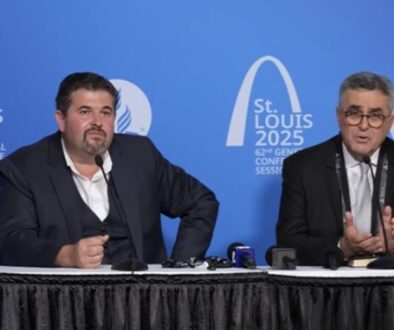Reworking Biblical Interpretation for Contemporary Adventists
by Terry Bottrell | 22 November 2022 |
Our children learn about literary devices such as hyperbole and similes when they study literature in school. They also investigate different literary genres such as poetry, drama, and narrative, as well as different approaches to drawing meaning from a text.
These lessons are important not just for reading secular literature such as Shakespeare and Jane Austin, but also for their understanding of sacred texts such as the Bible.
Literary devices
Jesus’ reference to “a camel going through the eye of a needle” in Mark 10:25 combines a metaphor with hyperbole to gain his audience’s attention and demonstrate God’s power to do what is impossible for us. Salvation is impossible to earn no matter how rich you are, he says, but with God all things are possible.
Jesus is also famous for his parables. In Luke’s account of the rich man and Lazarus (16:19-31), Jesus makes use of an existing story in circulation at the time to form the basis of his own parable. The parable can be interpreted in a variety of ways. Some have tried to use it to draw conclusions about the afterlife, but we Adventists have avoided false doctrinal conclusions from the parable because we have recognised the literary device Jesus is using. The larger themes in the story have to do with how wealth can calcify the heart, and that the measure we use to judge others will be used on us.
Literary genres
As a book composed of writings written over several thousand years, the Bible isn’t all one style or writing.
We have the wonderful wisdom literature of Proverbs and Ecclesiastes, ranging from the “love poetry” of Song of Solomon to the creation account in Genesis 1:1 to 2:3, which some believe has more to do with poetry than science.
Traditionally, Seventh-day Adventists have taken a literal approach to the creation account. But by examining the poetic structures in the passage we find a beautiful extra dimension. In the original Hebrew this story of creation is a chiastic poem. It has poetic balance in the way that days 1 and 4, 2 and 5, and 3 and 6 complement each other: In days 1, 2, and 3, the environment is created for the living things created on days 4, 5, and 6 to inhabit these environments.
There is also a central theme running from Genesis 1:2, where the earth is chaotic, to the order of the Sabbath depicted in day 7. This makes the Sabbath the climactic event of creation. When viewed from this perspective, the literal creation account is subservient to the author’s intention to stress the importance of the Sabbath.
In short, looking through the poetic lens doesn’t negate the power of the Sabbath. Rather, it enhances it because the poem is structured to communicate that the Sabbath is central to creation and God’s relationship with man.
Finding meaning
In his book When Everything’s on Fire, Brian Zahnd proposes that a reader can approach the Bible on three levels: as a literalist, as a theologian, or as a mystic. All approaches have their uses, depending on the reader’s needs and the outcomes sought.
The gospel narratives lend themselves to a literal reading. Jesus, most of us believe, really did miracles, and really did literally rise from the dead as detailed in the gospels.
Theologians take an analytical view. They study the sources of the text (such as the “Q” source of Mark, posited by some theologians) and then ask: what do the words mean, and how do they philosophically blend to create true propositions?
Theology can serve as a bridge to what Zahnd sees as a mystical reading. A story may be used as a source for a personal application and experience. In 1 Peter 3:20-21, for example, Peter uses the Noah story as a picture of baptism. The eight souls of Noah’s family saved through water model the antitype of baptism that now saves us. This interpretation isn’t literally in the flood story, but it still brings the Bible alive and makes it relevant to our circumstances.
Beyond Adventist literalism
The Adventist approach prior to October 22, 1844, was derived from Daniel 7-9, with a particular focus on Daniel 8:14. Old Testament theologians reading this verse today know that the Millerites interpreted it incorrectly—because what they expected didn’t happen. The use of the word “cleansed” in the King James Version, or the calculation of times involving days and years to lead to a particular date—October 22, 1844—proved not to be accurate to their expectations. We can legitimately ask: is the intended subject of this judgment the saints or the “little horn”?
After the disappointment, some of our pioneers used the literal calculations to focus in on an event—the cleansing of the sanctuary in heaven rather than the earth—that created a powerful mystical truth which inspired the hearts of the early Adventists. This mystical truth gave believers a powerful sense that they were living in the end times, thus transforming a broken group of people into the strong movement that is the Adventist church of today.
Yet I think the early Adventists might be surprised that we still rely on this mystical meaning nearly two centuries after it was crafted. Their concept of a pre-advent investigative judgement implies an imminent second advent. Too long a gap between the second coming and the start of the investigative judgement suggests that the mystical interpretation has outgrown its relevance. The early Adventists could not have imagined a delay of 178 years. We see their expectation that Christ would return soon in their belief in the “shut door,” for example. The following quote from Ellen White illustrates this mindset:
“I was shown the company present at the conference. Said the angel: ‘Some food for worms, some subjects of the seven last plagues, some will be alive and remain upon the earth to be translated at the coming of Jesus.”
Reworking old meanings
Discussions about these concerns have consumed countless resources in our church, while producing very little in the way of benefits to our walk with Jesus Christ.
It seems to me we should be open to reworking the literalist readings of Daniel 8:14 that inspired our pioneers, into a new mystical message that has meaning for this generation of Adventist Christians. These new meanings need to come from a new generation, and be relevant to the times in which we live.
A divergence between the ideas of the current generation and previous generations is inevitable, and it is not a threat to the church. New interpretations are something to be embraced, rather than opposed, as our church can add new layers of depth and understanding to our appreciation of the Bible.
The early Adventists focused on their mystical interpretation of the heavenly sanctuary. But biblical prophecy should relate to events on earth: it is for the benefit of the church as they live out the gospel in everyday life. What does Daniel 8:14 say to our children, and how they should live as followers of Jesus Christ in 2022?
Indeed, we may end up with less certainty around some of our more tenuous ideas. But this is a good thing, because certainty leads to intolerance which is the enemy of unity. This is summarized in a saying attributed to the German Lutheran theologian of the early seventeenth century, Rupertus Meldenius: “In essentials unity, in non-essentials diversity. and in all things love.”
 Terry Bottrell is a semi-retired Australian secondary teacher with a degree from Avondale College. He’s spent 30+ years teaching Bible, physical and outdoor education, math, and science for Adventist schools. He and his wife live in Brisbane.
Terry Bottrell is a semi-retired Australian secondary teacher with a degree from Avondale College. He’s spent 30+ years teaching Bible, physical and outdoor education, math, and science for Adventist schools. He and his wife live in Brisbane.




